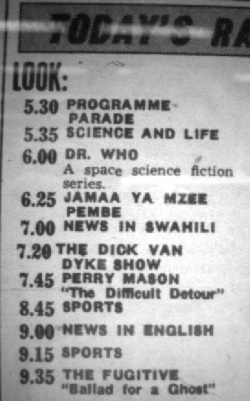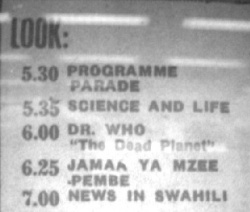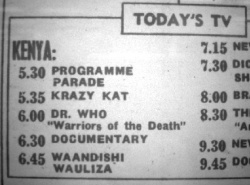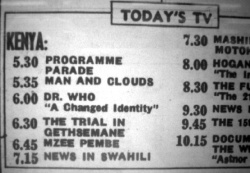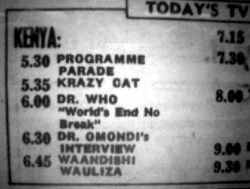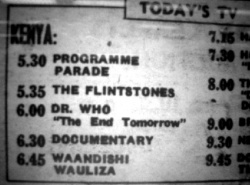Difference between revisions of "Kenya"
Jon Preddle (talk | contribs) |
Jon Preddle (talk | contribs) |
||
| (7 intermediate revisions by the same user not shown) | |||
| Line 8: | Line 8: | ||
|'''Region'''||[[:Category:Africa|Africa]]||Commonwealth | |'''Region'''||[[:Category:Africa|Africa]]||Commonwealth | ||
|- | |- | ||
| − | |'''Television commenced'''||1962|| | + | |'''Television commenced'''||1 October 1962|| |
|- | |- | ||
|'''Colour System'''||1978||[[:Wikipedia:PAL|PAL]] | |'''Colour System'''||1978||[[:Wikipedia:PAL|PAL]] | ||
| Line 23: | Line 23: | ||
==Television Stations / Channels== | ==Television Stations / Channels== | ||
| − | Kenya began its television service in 1962. | + | Kenya began its television service in October 1962, with a government-owned commercial broadcaster based in Nairobi. The station was called '''[[wikipedia:Kenya Broadcasting Corporation| Kenya Broadcasting Corporation]]''' when it was launched (with the assistance of [[TIE Ltd]]), but was renamed '''Voice of Kenya''' two years later in July 1964. |
| − | + | Colour transmissions began in 1978 using the [[Wikipedia:PAL|PAL]] colour broadcast system, although '''Doctor Who''' did not screen in colour in that country. | |
| − | + | The TV station name reverted back to '''Kenya Broadcasting Corporation''' in 1989. | |
| Line 98: | Line 98: | ||
====Origin of the Prints?==== | ====Origin of the Prints?==== | ||
| − | Kenya was served by the programme distributor '''[[TIE Ltd|Television International Enterprises Limited / TIE (Programmes) Ltd]]'''. The previous TIE Ltd client to screen the same set of 53 episodes was [[Aden]], however it is likely that [[Aden]]'s films were sent to [[ | + | Kenya was served by the programme distributor '''[[TIE Ltd|Television International Enterprises Limited / TIE (Programmes) Ltd]]'''. The previous [[TIE Ltd]] client to screen the same set of 53 episodes was [[Aden]], however it is likely that [[Aden]]'s films were sent to [[Trinidad]]. Being the first East African country in [[TIE Ltd]]'s network, the station may have acquired its own set of prints. |
| − | + | Alternatively, and probably the more likely, the films were sent over from [[Nigeria]]. | |
| Line 111: | Line 111: | ||
Finally starting on '''30 June 1966''', the series screened weekly, at 6.00pm. | Finally starting on '''30 June 1966''', the series screened weekly, at 6.00pm. | ||
| − | The series took a break for one week on '''25 May 1967''', midway through [[The Dalek Invasion of Earth]], to allow for delayed coverage of the | + | The series took a break for one week on '''25 May 1967''', midway through [[The Dalek Invasion of Earth]], to allow for delayed coverage of the 20 May 1967 FA Cup Final between Tottenham Hotspur and Chelsea at Wembley Stadium. |
The final episode (part two of [[The Rescue]]) is listed for both '''6 July and 13 July 1967'''; either the screening of the final episode was delayed by a week, or the newspaper erroneously reprinted the previous week's billing for '''Doctor Who''' instead of its replacement programme, [[wikipedia:The Adventures of Robin Hood (TV series)|The Adventures of Robin Hood]]. | The final episode (part two of [[The Rescue]]) is listed for both '''6 July and 13 July 1967'''; either the screening of the final episode was delayed by a week, or the newspaper erroneously reprinted the previous week's billing for '''Doctor Who''' instead of its replacement programme, [[wikipedia:The Adventures of Robin Hood (TV series)|The Adventures of Robin Hood]]. | ||
| Line 119: | Line 119: | ||
====Fate of the Prints?==== | ====Fate of the Prints?==== | ||
| − | Kenya was the last [[:Category:Africa|African]] country to air this batch of 53 episodes. Its prints may have been sent back to '''[[TIE Ltd]]''', returned to the BBC, or disposed of by other means. | + | Kenya was the last continental [[:Category:Africa|African]] country to air this batch of 53 episodes. Its prints may have been sent back to '''[[TIE Ltd]]''', returned to the BBC, or disposed of by other means., or perhaps sent to [[Mauritius]], which was the next [[TIE Ltd]] country to screen the series, starting in October 1966. |
| + | The first five serials may have gone to [[Mauritius]]. | ||
| + | |||
==TV listings== | ==TV listings== | ||
| Line 141: | Line 143: | ||
==Kenya in Doctor Who== | ==Kenya in Doctor Who== | ||
| + | *Deep Roy (Mr Sin in [[The Talons of Weng-Chiang]]) was born in Nairobi. | ||
* The 12 million year old skull was found in Kenya ([[Image of the Fendahl]]). | * The 12 million year old skull was found in Kenya ([[Image of the Fendahl]]). | ||
| + | *Sneh Gupta (Osborn in [[Resurrection of the Daleks]]) was born in Nairobi. | ||
Latest revision as of 01:17, 9 September 2024
KENYA is located on the east coast of the African continent. It is bordered by Ethiopia and Uganda.
Profile
| Country Number (18) | 1966 | FIRST WAVE |
| Region | Africa | Commonwealth |
| Television commenced | 1 October 1962 | |
| Colour System | 1978 | PAL |
| Population | 1966 | 8.9 million |
| TV Sets | 1966 | 11,500 |
| Language/s | English |
Television Stations / Channels
Kenya began its television service in October 1962, with a government-owned commercial broadcaster based in Nairobi. The station was called Kenya Broadcasting Corporation when it was launched (with the assistance of TIE Ltd), but was renamed Voice of Kenya two years later in July 1964.
Colour transmissions began in 1978 using the PAL colour broadcast system, although Doctor Who did not screen in colour in that country.
The TV station name reverted back to Kenya Broadcasting Corporation in 1989.
Language/s
The principal language of Kenya is English, plus many tribal dialects, such as Swahili.
DOCTOR WHO IN KENYA
Kenya was the 18th country to screen Doctor Who, and the fifth in Africa (see Selling Doctor Who).
BBC Records
The Stanmark Productions Ltd advertisement from 1966, identifies Kenya as one of the twelve countries screening Doctor Who in that year.
Kenya is named in the list of 27 countries in The Making of Doctor Who 1972 Piccolo edition.
The Seventies records a sale of "(7)" stories by 28 February 1977. The Handbook however identifies eight, being: A, C, D, E, H, J, K and L.
In DWM, Kenya is identified in 11 story Archives: B, C, D, E, F, G, H, J, K and L, as well as M, but this is an error.
Stories bought and broadcast
WILLIAM HARTNELL
Eleven stories, 53 episodes:
| A | An Unearthly Child | 4 |
| B | The Daleks | 7 |
| C | Inside the Spaceship | 2 |
| D | Marco Polo | 7 |
| E | The Keys of Marinus | 6 |
| F | The Aztecs | 4 |
| G | The Sensorites | 6 |
| H | The Reign of Terror | 6 |
| J | Planet of Giants | 3 |
| K | The Dalek Invasion of Earth | 6 |
| L | The Rescue | 2 |
Kenya therefore bought the standard package of GROUPs A, B and C of the William Hartnell stories.
The programme was supplied as 16mm black and white film prints with English soundtracks.
Origin of the Prints?
Kenya was served by the programme distributor Television International Enterprises Limited / TIE (Programmes) Ltd. The previous TIE Ltd client to screen the same set of 53 episodes was Aden, however it is likely that Aden's films were sent to Trinidad. Being the first East African country in TIE Ltd's network, the station may have acquired its own set of prints.
Alternatively, and probably the more likely, the films were sent over from Nigeria.
Transmission
WILLIAM HARTNELL
The debut of the series appears to have been delayed by three weeks; the first episode is billed in the 16 June, 23 June, and 30 June 1966 newspapers. (A similar delay prevented Zambia from screening the series on its intended first date as it was awaiting receipt of the film prints coming from Rhodesia, who in turn seems to have been waiting the prints to come from its supplier, possibly Gibraltar...)
Finally starting on 30 June 1966, the series screened weekly, at 6.00pm.
The series took a break for one week on 25 May 1967, midway through The Dalek Invasion of Earth, to allow for delayed coverage of the 20 May 1967 FA Cup Final between Tottenham Hotspur and Chelsea at Wembley Stadium.
The final episode (part two of The Rescue) is listed for both 6 July and 13 July 1967; either the screening of the final episode was delayed by a week, or the newspaper erroneously reprinted the previous week's billing for Doctor Who instead of its replacement programme, The Adventures of Robin Hood.
There is no clear record that Kenya screened Doctor Who again, even after the switch to colour in 1978.
Fate of the Prints?
Kenya was the last continental African country to air this batch of 53 episodes. Its prints may have been sent back to TIE Ltd, returned to the BBC, or disposed of by other means., or perhaps sent to Mauritius, which was the next TIE Ltd country to screen the series, starting in October 1966.
The first five serials may have gone to Mauritius.
TV listings
| ← AIRDATES ...... (CLICK ICON TO GO TO TABLE SHOWING EPISODE BREAKDOWN AND AIRDATES - N/S = story title is Not Stated) |
TV listings have been obtained from the Nairobi newspapers Daily Nation and East African Standard.
The 30 June 1966 edition of East African Standard previews the new series: "Dr Who - A space science fiction series featuring William Hartnell as Dr Who, an intrepid voyager whose adventures lead him into the past, present and the future."
The Daily Nation simply says it's: "A space science fiction series".
While both papers list the series as starting on 16 June 1966, the fact that the listings for "Episode 2" on 7 July and The Forest of Fear on 14 July indicates that the series ended up starting three weeks later than was originally scheduled.
All listings give the series name as "DR WHO" (in capitals). All but four episode titles were listed in the papers. Several of the given titles were wrong: part two of The Aztecs was given as "Warriors of the Death"; part three of The Reign of Terror was "A Changed Identity", and part five was "A Bargaining of Necessity"; The Dalek Invasion of Earth part four was "The End Tomorrow", and five was "The Walking Ally".
The billings for Planet of Giants and The Dalek Invasion of Earth also got scrambled in April 1967, with the listings indicating that the first episode of the latter aired between parts one and two of the former.
Curiously, part one of the Dalek serial was given as "World's End No Break", which is presumably from someone down the line misreading a note that there was no commercial break during this episode and providing said note to the newspaper!
Kenya in Doctor Who
- Deep Roy (Mr Sin in The Talons of Weng-Chiang) was born in Nairobi.
- The 12 million year old skull was found in Kenya (Image of the Fendahl).
- Sneh Gupta (Osborn in Resurrection of the Daleks) was born in Nairobi.
